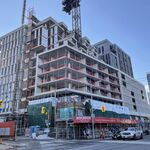We may be straying into the topic of the
Roads: Traffic Signals thread, but anyway...
Yes, to sum up, San Diego has disabled its transit priority system and instead introduced a green wave in the normal signal timings that is optimized for the expected transit travel times. The advantages of that option are that, like you said, by avoiding abrupt actions by the priority system, you can also avoid impact on other road users such as streetcars going the opposite direction.
But the limitations of that option are that
1. Coordination only works between intersections where there is no streetcar stop in between, because otherwise there is too much variability to guess when the streetcar would need the next green - they allude to this in the second article mentioning that the time spent at (red lights at) stops has increased. In SD, that's okay because there are so many intersections without stops that you make up can that time elsewhere.
2. You can only create a green wave in one direction, unless the blocks are evenly spaced at half-signal-cycle travel time between blocks. Downtown SD has a perfectly regular grid, which might have the right dimensions to provide a green wave in both directions.
Based on these constraints, the SD approach of a simple timed 'streetcar green wave' is a non-starter in the King Street pilot because
1. There is a stop at every signal except York St and Simcoe St.
2. The signals are not ideally spaced to make a green wave possible in both directions. With unevenly spaced signals and two-way service on the same street, you would need to compromise the green wave in one direction to avoid completely screwing over the green wave in the other.
The best option would be to stick with active (i.e. detection-based) priority, and supplement it with a green wave at Simcoe and York to get even more benefits. The two strategies are not mutually exclusive, they can actually be combined.






